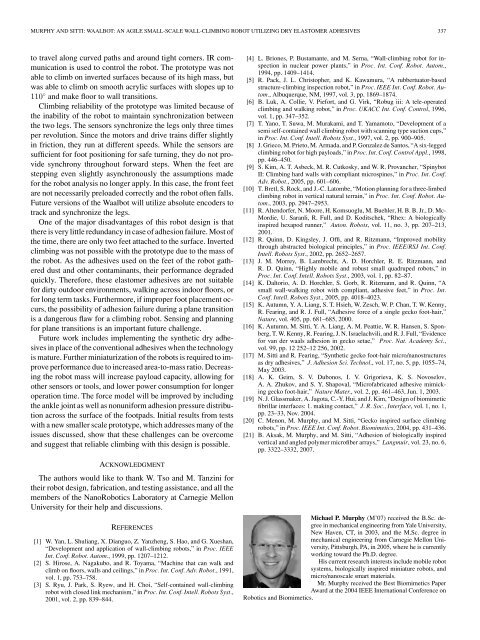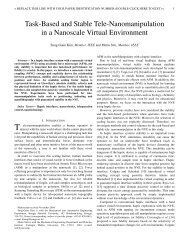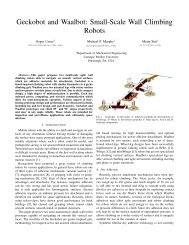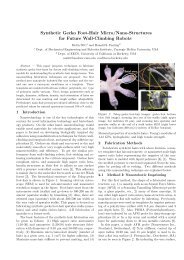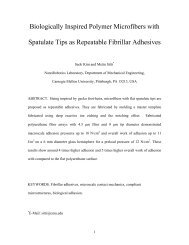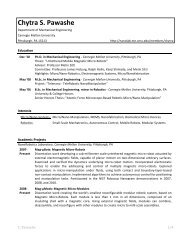Waalbot - NanoRobotics Lab - Carnegie Mellon University
Waalbot - NanoRobotics Lab - Carnegie Mellon University
Waalbot - NanoRobotics Lab - Carnegie Mellon University
Create successful ePaper yourself
Turn your PDF publications into a flip-book with our unique Google optimized e-Paper software.
MURPHY AND SITTI: WAALBOT: AN AGILE SMALL-SCALE WALL-CLIMBING ROBOT UTILIZING DRY ELASTOMER ADHESIVES 337<br />
to travel along curved paths and around tight corners. IR communication<br />
is used to control the robot. The prototype was not<br />
able to climb on inverted surfaces because of its high mass, but<br />
was able to climb on smooth acrylic surfaces with slopes up to<br />
110 ◦ and make floor to wall transitions.<br />
Climbing reliability of the prototype was limited because of<br />
the inability of the robot to maintain synchronization between<br />
the two legs. The sensors synchronize the legs only three times<br />
per revolution. Since the motors and drive trains differ slightly<br />
in friction, they run at different speeds. While the sensors are<br />
sufficient for foot positioning for safe turning, they do not provide<br />
synchrony throughout forward steps. When the feet are<br />
stepping even slightly asynchronously the assumptions made<br />
for the robot analysis no longer apply. In this case, the front feet<br />
are not necessarily preloaded correctly and the robot often falls.<br />
Future versions of the <strong>Waalbot</strong> will utilize absolute encoders to<br />
track and synchronize the legs.<br />
One of the major disadvantages of this robot design is that<br />
there is very little redundancy in case of adhesion failure. Most of<br />
the time, there are only two feet attached to the surface. Inverted<br />
climbing was not possible with the prototype due to the mass of<br />
the robot. As the adhesives used on the feet of the robot gathered<br />
dust and other contaminants, their performance degraded<br />
quickly. Therefore, these elastomer adhesives are not suitable<br />
for dirty outdoor environments, walking across indoor floors, or<br />
for long term tasks. Furthermore, if improper foot placement occurs,<br />
the possibility of adhesion failure during a plane transition<br />
is a dangerous flaw for a climbing robot. Sensing and planning<br />
for plane transitions is an important future challenge.<br />
Future work includes implementing the synthetic dry adhesives<br />
in place of the conventional adhesives when the technology<br />
is mature. Further miniaturization of the robots is required to improve<br />
performance due to increased area-to-mass ratio. Decreasing<br />
the robot mass will increase payload capacity, allowing for<br />
other sensors or tools, and lower power consumption for longer<br />
operation time. The force model will be improved by including<br />
the ankle joint as well as nonuniform adhesion pressure distribution<br />
across the surface of the footpads. Initial results from tests<br />
with a new smaller scale prototype, which addresses many of the<br />
issues discussed, show that these challenges can be overcome<br />
and suggest that reliable climbing with this design is possible.<br />
ACKNOWLEDGMENT<br />
The authors would like to thank W. Tso and M. Tanzini for<br />
their robot design, fabrication, and testing assistance, and all the<br />
members of the <strong>NanoRobotics</strong> <strong>Lab</strong>oratory at <strong>Carnegie</strong> <strong>Mellon</strong><br />
<strong>University</strong> for their help and discussions.<br />
REFERENCES<br />
[1] W. Yan, L. Shuliang, X. Dianguo, Z. Yanzheng, S. Hao, and G. Xueshan,<br />
“Development and application of wall-climbing robots,” in Proc. IEEE<br />
Int. Conf. Robot. Autom., 1999, pp. 1207–1212.<br />
[2] S. Hirose, A. Nagakubo, and R. Toyama, “Machine that can walk and<br />
climb on floors, walls and ceilings,” in Proc. Int. Conf. Adv. Robot., 1991,<br />
vol. 1, pp. 753–758.<br />
[3] S. Ryu, J. Park, S. Ryew, and H. Choi, “Self-contained wall-climbing<br />
robot with closed link mechanism,” in Proc. Int. Conf. Intell. Robots Syst.,<br />
2001, vol. 2, pp. 839–844.<br />
[4] L. Briones, P. Bustamante, and M. Serna, “Wall-climbing robot for inspection<br />
in nuclear power plants,” in Proc. Int. Conf. Robot. Autom.,<br />
1994, pp. 1409–1414.<br />
[5] R. Pack, J. L. Christopher, and K. Kawamura, “A rubbertuator-based<br />
structure-climbing inspection robot,” in Proc. IEEE Int. Conf. Robot. Autom.,<br />
Albuquerque, NM, 1997, vol. 3, pp. 1869–1874.<br />
[6] B. Luk, A. Collie, V. Piefort, and G. Virk, “Robug iii: A tele-operated<br />
climbing and walking robot,” in Proc. UKACC Int. Conf. Control, 1996,<br />
vol. 1, pp. 347–352.<br />
[7] T. Yano, T. Suwa, M. Murakami, and T. Yamamoto, “Development of a<br />
semi self-contained wall climbing robot with scanning type suction cups,”<br />
in Proc. Int. Conf. Intell. Robots Syst., 1997, vol. 2, pp. 900–905.<br />
[8] J. Grieco, M. Prieto, M. Armada, and P. Gonzalez de Santos, “A six-legged<br />
climbing robot for high payloads,” in Proc. Int. Conf. Control Appl., 1998,<br />
pp. 446–450.<br />
[9] S. Kim, A. T. Asbeck, M. R. Cutkosky, and W. R. Provancher, “Spinybot<br />
II: Climbing hard walls with compliant microspines,” in Proc. Int. Conf.<br />
Adv. Robot., 2005, pp. 601–606.<br />
[10] T. Bretl, S. Rock, and J.-C. Latombe, “Motion planning for a three-limbed<br />
climbing robot in vertical natural terrain,” in Proc. Int. Conf. Robot. Autom.,<br />
2003, pp. 2947–2953.<br />
[11] R. Altendorfer, N. Moore, H. Komsuoglu, M. Buehler, H. B. B. Jr., D. Mc-<br />
Mordie, U. Saranli, R. Full, and D. Koditschek, “Rhex: A biologically<br />
inspired hexapod runner,” Auton. Robots, vol. 11, no. 3, pp. 207–213,<br />
2001.<br />
[12] R. Quinn, D. Kingsley, J. Offi, and R. Ritzmann, “Improved mobility<br />
through abstracted biological principles,” in Proc. IEEE/RSJ Int. Conf.<br />
Intell. Robots Syst., 2002, pp. 2652–2657.<br />
[13] J. M. Morrey, B. Lambrecht, A. D. Horchler, R. E. Ritzmann, and<br />
R. D. Quinn, “Highly mobile and robust small quadruped robots,” in<br />
Proc. Int. Conf. Intell. Robots Syst., 2003, vol. 1, pp. 82–87.<br />
[14] K. Daltorio, A. D. Horchler, S. Gorb, R. Ritzmann, and R. Quinn, “A<br />
small wall-walking robot with compliant, adhesive feet,” in Proc. Int.<br />
Conf. Intell. Robots Syst., 2005, pp. 4018–4023.<br />
[15] K. Autumn, Y. A. Liang, S. T. Hsieh, W. Zesch, W. P. Chan, T. W. Kenny,<br />
R. Fearing, and R. J. Full, “Adhesive force of a single gecko foot-hair,”<br />
Nature, vol. 405, pp. 681–685, 2000.<br />
[16] K. Autumn, M. Sitti, Y. A. Liang, A. M. Peattie, W. R. Hansen, S. Sponberg,<br />
T. W. Kenny, R. Fearing, J. N. Israelachvili, and R. J. Full, “Evidence<br />
for van der waals adhesion in gecko setae,” Proc. Nat. Academy Sci.,<br />
vol. 99, pp. 12 252–12 256, 2002.<br />
[17] M. Sitti and R. Fearing, “Synthetic gecko foot-hair micro/nanostructures<br />
as dry adhesives,” J. Adhesion Sci. Technol., vol. 17, no. 5, pp. 1055–74,<br />
May 2003.<br />
[18] A. K. Geim, S. V. Dubonos, I. V. Grigorieva, K. S. Novoselov,<br />
A. A. Zhukov, and S. Y. Shapoval, “Microfabricated adhesive mimicking<br />
gecko foot-hair,” Nature Mater., vol. 2, pp. 461–463, Jun. 1, 2003.<br />
[19] N. J. Glassmaker, A. Jagota, C.-Y. Hui, and J. Kim, “Design of biomimetic<br />
fibrillar interfaces: 1. making contact,” J. R. Soc., Interface, vol. 1, no. 1,<br />
pp. 23–33, Nov. 2004.<br />
[20] C. Menon, M. Murphy, and M. Sitti, “Gecko inspired surface climbing<br />
robots,” in Proc. IEEE Int. Conf. Robot. Biomimetics, 2004, pp. 431–436.<br />
[21] B. Aksak, M. Murphy, and M. Sitti, “Adhesion of biologically inspired<br />
vertical and angled polymer microfiber arrays,” Langmuir, vol. 23, no. 6,<br />
pp. 3322–3332, 2007.<br />
Michael P. Murphy (M’07) received the B.Sc. degree<br />
in mechanical engineering from Yale <strong>University</strong>,<br />
New Haven, CT, in 2003, and the M.Sc. degree in<br />
mechanical engineering from <strong>Carnegie</strong> <strong>Mellon</strong> <strong>University</strong>,<br />
Pittsburgh, PA, in 2005, where he is currently<br />
working toward the Ph.D. degree.<br />
His current research interests include mobile robot<br />
systems, biologically inspired miniature robots, and<br />
micro/nanoscale smart materials.<br />
Mr. Murphy received the Best Biomimetics Paper<br />
Award at the 2004 IEEE International Conference on<br />
Robotics and Biomimetics.


